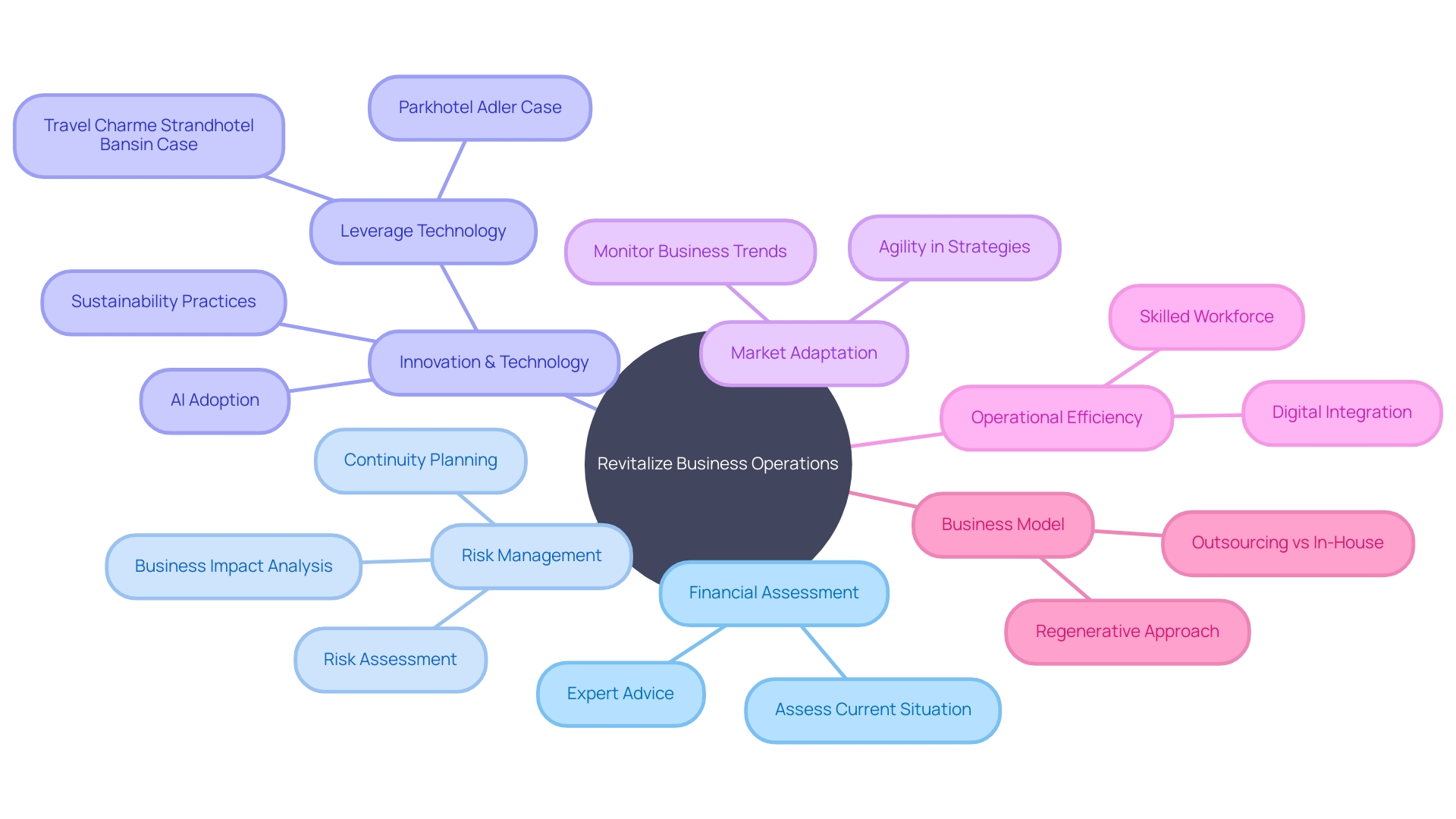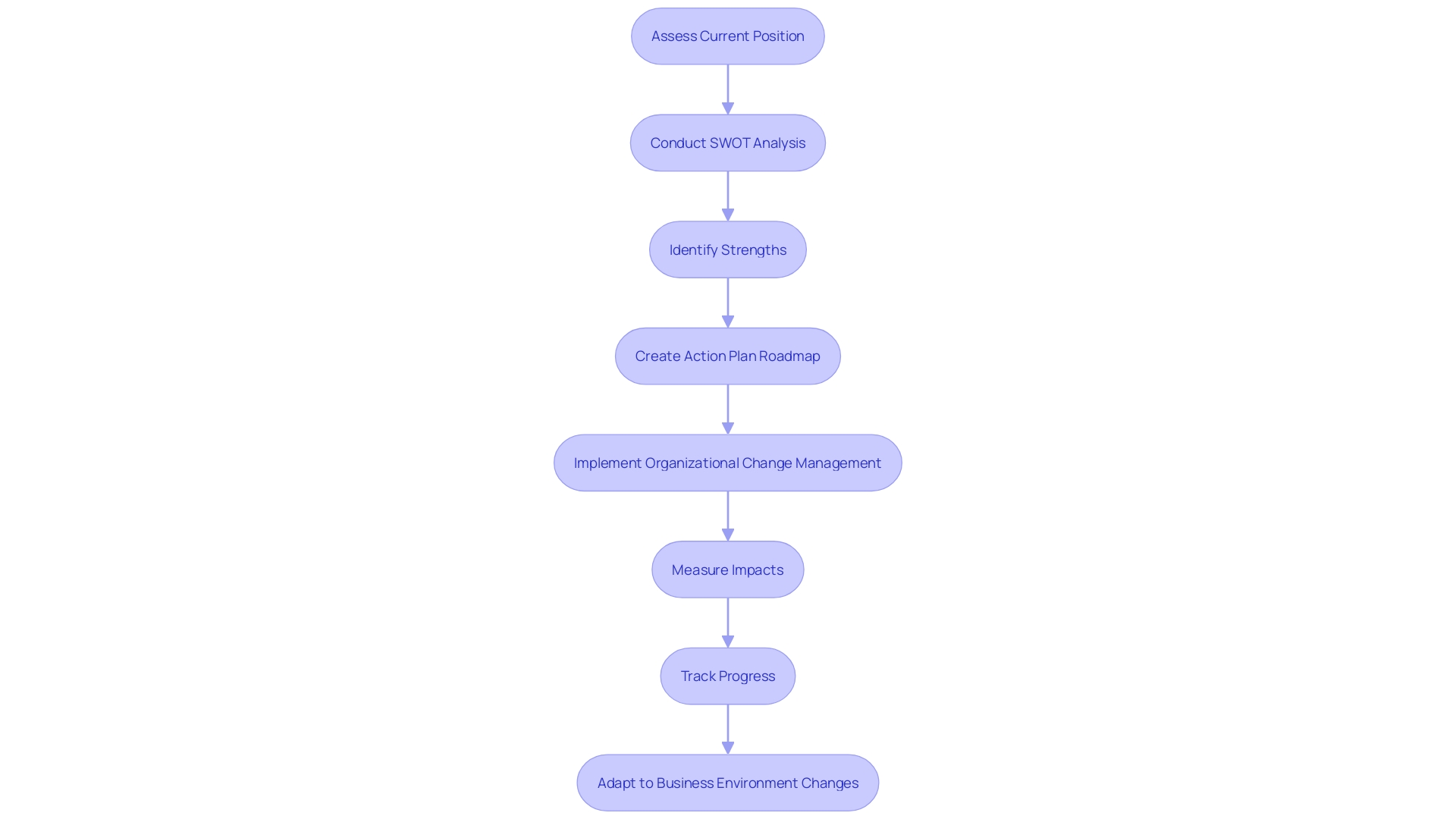Introduction
In today's dynamic business landscape, recognizing the need for restructuring and turnaround is crucial for maintaining relevance and competitive advantage. Whether it's stagnant sales, operational inefficiencies, or the need to adapt to market shifts, businesses must evaluate their current state and take decisive action. This article explores the urgency of restructuring and turnaround, the key differences between the two, and how to identify the right approach for your business.
It also delves into developing a plan of action, implementing strategies effectively, the role of consultants in the process, and the benefits they bring. Additionally, the article showcases successful case studies, provides tips for successful implementation and monitoring, and highlights the importance of continuous evaluation and adaptation. By adopting a confident and action-oriented tone, this article provides practical advice and solutions to CFOs and other financial professionals seeking to navigate the complexities of restructuring and turnaround in today's business environment.
Recognizing the Urgency of Restructuring and Turnaround
When an enterprise encounters market shifts or competitive pressures, it's essential to recognize when strategic restructuring or a turnaround may be necessary to maintain relevance and competitive advantage. For instance, a major branded hotel, despite its prime city center location, struggled with stagnant Food & Beverage sales. The key to revitalization was identified as knowing the market and leveraging the location to attract more diners, a strategy that resulted in immediate positive feedback and a significant sales uplift.
A comprehensive analysis of a business's operational efficiency, like reviewing supply chain processes and identifying any significant disruptions, is fundamental in determining the need for restructuring. Moreover, a deep dive into financial performance, evaluating income statements, balance sheets, and cash flow statements can reveal vital insights into revenue growth, profit margins, cost management, and investment returns. These factors are critical for informed decision-making concerning future financial planning and resource allocation.
Marketing strategies and customer engagement also play a pivotal role in identifying the necessity for change. Evaluating the effectiveness of marketing campaigns and the growth of the customer base can indicate whether a new approach is warranted. For instance, Rite Aid Corporation's restructuring plan, aimed at reducing debt and increasing financial flexibility, demonstrates the importance of continuous transformation in a dynamic business environment, where traditional 'unfreeze-change-refreeze' models may no longer suffice.
Real-world cases like IBL, active in various sectors, show that even with a strong entrepreneurial background, businesses must balance their innovation portfolios and respond to external factors like pandemics and conflicts. These examples, alongside statistical evidence that proactive transformations lead to higher shareholder returns compared to reactive ones, underscore the importance of continuous evaluation and adaptation to maintain a successful, future-proof business.

Key Differences Between Turnaround and Restructuring
Understanding the distinction between turnaround and restructuring is essential for businesses plotting a course through turbulent times. Turnaround strategies are akin to a skilled captain steering a ship through a storm, aiming to revive and rejuvenate a floundering enterprise. It's about adjusting the sails - marketing tactics, cost-efficiency measures, and operational improvements - to catch the wind of market demand once more. On the other hand, restructuring is the act of overhauling the ship itself; it's a fundamental reorganization of a company's structure, operations, and financial arrangements to stabilize an unsteady vessel in choppy financial waters.
A real-world example is the transformation witnessed at a prominent city center hotel, unable to boost its food and beverage sales despite an enviable location. The strategy shifted to leveraging its prime position to attract diners, a turnaround tactic that involved understanding the market intimately. This approach yielded immediate results, garnering excellent reviews and a significant uptick in sales in the first week.
In contrast, TBC Bank's journey reflects the restructuring route. With aspirations of becoming a digital leader and expanding internationally, the bank embarked on a path of agile transformation, streamlining its organizational complexity to foster growth. The restructuring involved adopting new structures and modern agile methodologies, aiming to reduce the entanglements of daily operations.
These strategies are not static; they evolve with the business landscape. As noted by experts, transformation should be treated as a continuous process, not a one-time fix. This philosophy, inspired by psychologist Kurt Lewin's "unfreeze-change-refreeze" model, suggests that change is an ongoing cycle rather than a finite project.
Financial news from companies like Polestar and Rite Aid Corporation exemplifies forward-looking statements that often encompass both turnaround and restructuring themes. These statements predict future performance based on strategies that may include optimizing revenue streams, enhancing margins, achieving cash flow break-even, and ensuring long-term sustainability - all while navigating the complexities of supply chains, partnerships, and market forces.
Ultimately, whether a company chooses turnaround strategies, opts for restructuring, or blends both, the goal remains the same: to sail through tough times and emerge stronger on the other side.
Identifying the Right Approach for Your Business
Selecting the optimal strategy for revitalizing a business's operations is a nuanced process that requires a multi-faceted evaluation of the company's current state, industry trends, and internal strengths. For instance, Travel Charme Strandhotel Bansin leveraged technology to enhance guest experiences and streamline operations, a move that proved to be a decisive factor in their success. Similarly, Parkhotel Adler overcame technology constraints to modernize its marketing approach, using segmentation and personalization to great effect. These case studies illustrate the profound impact of tailored strategies, informed by a solid understanding of the market and internal capabilities.
Furthermore, it's essential to stay abreast of broader business trends, such as the adoption of AI and sustainability practices that are reshaping industries. As noted by GreenBiz, sustainability trends, including decarbonization and ESG, are transforming business operations, a movement that's gaining momentum in 2023. These trends highlight the importance of aligning business restructuring efforts with evolving market demands and regulatory landscapes.
To ensure a comprehensive approach, businesses should also consider financial assessments, leveraging expert advice on investments and financial management. As Bryan Solis's research indicates, market competition and growth opportunities often necessitate change, with 79.7% of businesses needing to adapt every few years. This statistic underscores the imperative for continuous innovation and agility in business strategies.
Ultimately, the goal is to establish a regenerative business model that builds on itself through operational efficiency, skilled workforce, and the integration of digital technology, as advocated by experts in the field. This may involve considering outsourcing opportunities, as well as developing in-house capabilities, to create a resilient and forward-looking business structure that thrives in today's dynamic market environment.

Assessing Your Current Situation
Conducting a thorough analysis of a business's health before undertaking restructuring is essential. This process should begin with a deep dive into the company's financial performance. By examining income statements, balance sheets, and cash flow statements, leaders can gauge revenue growth, profit margins, cost management, and investment returns, which are pivotal for future financial planning and resource allocation. Operational efficiency and supply chain management also warrant close scrutiny to identify potential disruptions and assess overall process efficiency. Additionally, evaluating marketing and customer engagement strategies is critical. Questions like 'How effective were our marketing strategies in reaching our target audience?' and 'What was the growth in our customer base?' help understand the impact of marketing efforts.
Understanding market position and competition is equally important. With 21% of UK businesses with 10 or more employees having exported goods or services in the past year, according to the Business Insights and Conditions Survey, the competitive landscape is dynamic and can influence a company's strategic direction. The survey also reveals that 16% of these businesses saw an increase in exports, while 24% experienced a decrease, suggesting variability in market success.
Historical case studies, such as Xerox's struggle to pivot despite recognizing changes in technology and consumer behavior, highlight the need for agility and adaptation. With the highest number of company insolvencies since 1993 recorded in 2023, the stakes for businesses to stay relevant and responsive to market shifts are higher than ever.
In summary, a comprehensive assessment of a business's current situation across financial, operational, and market dimensions is imperative to inform decisions and craft an effective action plan for restructuring or turnaround efforts.

Developing a Plan of Action
Developing a robust plan of action is essential for steering a business towards its intended objectives. This calls for a meticulous approach that begins with assessing the company's current position, reviewing the outcomes of prior resolutions, and understanding the internal and external forces through a comprehensive SWOT analysis. This analysis should highlight the firm's strengths, such as a dominant brand or skilled workforce, to leverage them for competitive advantage. An action plan, akin to a roadmap, is a systematic framework that details the steps necessary to transition from the current state to the desired future. This blueprint covers various facets, including organizational change management, which is fundamental in guiding a company through significant shifts. It consists of preparation, implementation, and follow-through stages, all orchestrated to support the organization's transformation.
A successful action plan is not a one-off event but a continuous process that adapts to the dynamism of the business environment. It integrates the wisdom of psychologist Kurt Lewin's 'unfreeze-change-refreeze' model while recognizing that modern businesses must stay in a perpetual state of transformation to thrive. The plan should measure impacts, track progress, and evolve as changes in market dynamics, customer preferences, and industry trends emerge. By crafting a plan that is both detailed and adaptable, businesses can navigate change efficiently and achieve their goals with precision.

Implementing Turnaround and Restructuring Strategies
Turnaround and restructuring are pivotal for businesses aiming to navigate through financial turbulence and emerge stronger. Successful strategies are multifaceted, focusing not only on immediate financial stabilization but also on fostering a culture of continuous improvement. An illustrative case is a city-centered hotel that overcame stagnant F&B sales by leveraging its prime location to attract diners, underscoring the importance of market awareness in strategy formulation. Similarly, TBC Bank's agile transformation showcases how reducing organizational complexity can drive growth, aligning with the philosophy that change is an ongoing journey rather than a finite project. Companies like Northvolt, acknowledging the challenges of scaling up sustainable large-scale cell manufacturing, have committed to strategic reviews to hone their focus and ensure financial solidity. These examples highlight the necessity for distressed organizations to implement a strategic budget, identify bottlenecks such as unrealistic KPIs or decision-making processes, and embrace flexibility to adapt to the ever-evolving business landscape. By adopting a mindset of continuous transformation, as advised by the unfreeze-change-refreeze model of psychologist Kurt Lewin, businesses can maintain momentum in their restructuring efforts and secure long-term success.

Role of Consultants in Turnaround and Restructuring
Amidst economic shifts and market pressures, consultants are becoming the linchpins of successful business turnarounds and restructuring, especially in sectors such as business and construction. Their external vantage point, coupled with specialized knowledge, can diagnose issues that may elude internal stakeholders, leading to transformative solutions and strategies. For instance, Virtusa Corporation exemplifies how an 'Engineering First' mindset can lead to robust digital solutions that catalyze growth and efficiency in various industries. Moreover, consultants like John Young demonstrate the importance of location and market understanding in revitalizing a hotel's food and beverage sales, leading to immediate positive feedback and a spike in revenue. These real-world successes underscore the multifaceted role consultants play—from strategizing to executing solutions.
The dynamism of the consulting industry is further highlighted by the evolving nature of consultancy roles. Today, consultants are not merely advisors but also specialists who actively engage in the implementation of their recommendations, bringing a hands-on approach to problem-solving. This shift is driven by the need for tangible results and the desire to avoid the 'consultant stigma' of all talk and no action. As they engage more deeply in the operational aspects of businesses, consultants are instrumental in driving change and delivering value.
Small business consulting, in particular, has become a critical tool for growth and innovation. These consultants offer tailored advice on sales strategies, marketing campaigns, project management, and financial planning. Their objective guidance is backed by the latest market research and customized coaching, which allows small businesses to streamline operations and strengthen their brand presence.
The value of consultants is also reflected in the broader business landscape, with CEOs often drawing on their consulting experiences to navigate leadership challenges. Statistics reveal that CEOs who proactively engage in transformation efforts, rather than waiting for downturns, achieve higher total shareholder returns. Consultants are at the forefront of this proactive approach, equipping leaders with the tools to anticipate and address potential issues before they escalate.
In a world where adaptability and innovation are paramount, the role of consultants in business and construction restructuring cannot be overstated. Their expertise in interpreting data, offering actionable insights, and implementing solutions empowers businesses to navigate complex challenges and emerge stronger.
Benefits of Hiring Restructuring Consultants
Specialized restructuring consultants offer a lifeline for businesses facing turbulent times. They bring a fresh perspective, untainted by company politics or culture, allowing for an impartial evaluation of the financial and operational state of the business. These experts craft bespoke strategies that address the unique challenges and leverage opportunities within the company's ecosystem. Leveraging cutting-edge technology and innovative approaches like digital engineering, they can usher in transformative changes that ensure the business remains competitive and agile in a rapidly evolving marketplace.
For example, a hotel that struggled to capitalize on its prime location saw a turnaround by revamping its restaurant strategy. By understanding the market and employing a multi-disciplinary approach, the consultant developed a solution that led to increased sales and excellent customer reviews within the first week. Similarly, small business consultants act as coaches, offering a gamut of services from sales strategies to IT, helping businesses refine their operations and align with market demands.
With the business landscape being reshaped by technology and global events, companies are increasingly in need of restructuring to stay afloat. A staggering 79.7% of businesses must adapt every two to five years to survive. This constant need for evolution underscores the consultant's role in providing strategic insights grounded in financial modelling and industry research. Their contributions can be pivotal, whether it's a small business seeking to build its brand or a global corporation like Virtusa, which integrates its digital engineering prowess into every solution, ensuring that innovative ideas are executable and impactful from the get-go.
In a time when even the giants of the consulting world are facing headwinds, with firms like McKinsey and Accenture announcing significant job cuts, the value of targeted, effective consulting becomes more pronounced. These shifts in the consulting industry reflect the broader economic uncertainties, prompting businesses to reconsider long-term investments and focus on strategies that deliver immediate and sustainable results. Restructuring consultants are at the forefront of this shift, guiding businesses through complexity with strategic divestments, smart use of technology, and operational simplification to achieve financial stability and growth.
Case Study: Successful Turnaround and Restructuring Examples
Examining the narratives of companies who have successfully navigated restructuring and turnaround offers an abundance of practical knowledge for businesses in similar straits. A case in point is the Ford Foundation, a notable entity striving to dismantle inequality. Initially, their digital platform couldn't keep up with the growth in content being produced, signaling a need for an overhaul. Bedirhan Cinar, the head of product and digital engagement, pointed out that although their content output had escalated from a couple of pieces per month to several per week, their content management workflow had remained stagnant.
In another instance, a major hotel in a bustling city center struggled to ramp up food and beverage sales through its sole restaurant. The adoption of a strategic approach, focusing on the restaurant's prime location to draw in more diners, proved to be pivotal. John Young emphasizes the importance of knowing your market as the foremost step in either refurbishing or launching a dining establishment.
In the world of holiday hotels, Travel Charme Hotels & Resorts exemplifies how technology can enhance operations. Greg Smlatic, general manager of the Travel Charme Strandhotel Bansin, shared how the hotel caters to peak demands and retains its popularity amongst holiday-goers, thanks to its technology-driven strategies.
These success stories underscore the sentiment expressed by experts: the key to navigating business adjustments is a well-organized process for listening to signals from customers and team members. This approach enables businesses to identify and prioritize potential risks, develop mitigation strategies, and maintain a state of continuous transformation.
Statistics bolster the importance of treating transformation as an ongoing journey rather than a finite project with a beginning and end. This continuous process model is essential in an era where change is a constant, and businesses cannot afford to 'refreeze' and become complacent.
Through these insights, it's evident that successful restructuring and turnaround hinge on strategic planning, customer and team engagement, and a dynamic approach to transformation. This knowledge not only inspires but also provides actionable guidance for businesses aiming to revitalize their operations.

Tips for Successful Implementation and Monitoring
The landscape of business and construction is constantly evolving, and staying ahead often requires a fundamental shift in operations and management. Executing a successful turnaround or restructuring plan is not a one-time event; it is a continuous process that requires meticulous monitoring and adaptive measures to ensure long-term viability.
For organizations embarking on significant transformation journeys, it's crucial to have a clear roadmap and a rigorous assessment strategy. This involves developing practical tools, such as 'history books' that document key events related to asset operation, maintenance, and renewal. These records capture essential data like timelines, reasons, locations, methods, personnel involved, and associated costs. Not only do they provide a comprehensive overview of past actions, but they also guide future decisions and foster knowledge transfer, especially beneficial for new staff members.
Moreover, fostering a culture of change management is pivotal. This goes beyond the operational aspect and delves into the human side of transformation, which is often the make-or-break factor in the success of such initiatives. A people-centric approach ensures that the workforce understands and embraces the necessity of transformation, overcoming resistance and fear of technology. In fact, studies have shown that proactive leadership in change management significantly heightens the chances of achieving desired outcomes.
For instance, aligning with Joan Beets' perspective, recognizing and addressing the emotional and psychological impact of restructuring on employees is paramount. Anxiety and stress are common responses to change, and acknowledging these emotions is an integral part of the transformation process. Additionally, it's essential to determine the transformation's scope, set the correct priorities, and ensure the involvement of all designated personnel.
Real-world examples, like the transformation of Rwanda's healthcare system through digital health platforms, highlight the effectiveness of well-planned and executed initiatives. By upgrading infrastructure and adopting an integrated electronic medical record system, Rwanda has demonstrated the power of strategic restructuring in enhancing service delivery.
In the corporate world, companies like Rite Aid have shown that a structured, court-supervised financial restructuring approach can significantly reduce debt and increase operational flexibility, thereby facilitating business transformation and ensuring customer service continuity. This underscores the importance of strategic planning and stakeholder consensus in successful turnaround endeavors.
In conclusion, successful restructuring and turnaround strategies require a multifaceted approach that includes careful planning, ongoing reassessment, and a strong focus on change management. By integrating these elements, organizations can navigate the complexities of transformation and emerge stronger and more resilient.
Conclusion
Restructuring and turnaround are crucial for businesses to maintain relevance and competitive advantage. Understanding the differences between the two is essential; turnaround adjusts tactics, while restructuring involves a fundamental reorganization.
Selecting the right approach requires evaluating the company's current state, industry trends, and strengths. Stay updated on business trends and align restructuring efforts with market demands. Analyze financial performance, operational efficiency, supply chain, marketing strategies, and market position.
Develop a robust plan of action by assessing the company's position, conducting a SWOT analysis, and creating a roadmap. Successful plans are continuous, adapting to the dynamic business environment.
Turnaround and restructuring strategies are pivotal for navigating financial turbulence and fostering continuous improvement. Hiring restructuring consultants brings fresh perspectives, impartial evaluations, and tailored strategies.
Examining successful case studies provides practical knowledge, emphasizing strategic planning, customer and team engagement, and dynamic approaches.
Executing successful plans requires meticulous monitoring and adaptive measures. Have a clear roadmap, foster change management, address emotional impacts, and involve designated personnel.
In conclusion, successful restructuring and turnaround strategies require careful planning, ongoing reassessment, and a strong focus on change management. By integrating these elements, businesses can emerge stronger and more resilient.




